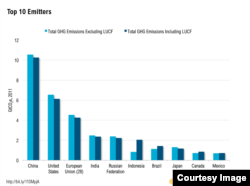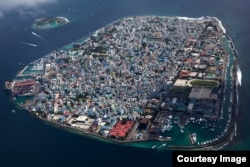Despite the recent terrorist attacks in the French capital, the climate meeting set for November 30-December 11 in Paris will go ahead as scheduled. Here's a primer on what the negotiations are all about.
More than 140 heads of state and ministers have confirmed that they will attend the meeting to finalize the Paris Climate Agreement, a new global treaty to reduce climate-changing emissions.
The two-week summit will host 40,000 delegates and organizers from 130 nongovernmental organizations. Unlike previous U.N. climate meetings, world leaders will arrive first, setting the parameters for the negotiators in crafting a new accord.
Security
Concerts, rallies and a People’s Climate March were expected to draw large crowds. These events were canceled for security reasons after the November 13 terrorist attacks that killed 130 people. Security will be paramount — the French police and army will be on the streets, and the venue will be patrolled by uniformed U.N. guards.
Bonn draft agreement
Negotiators agreed to a 51-page draft treaty in Bonn in October. Christiana Figueres, executive secretary of the U.N. Framework Convention on Climate Change (UNFCCC), said the draft includes options that reflect the concerns of all countries. She called the text "balanced and complete. The challenge for governments is to bring it down to a much more concise and coherent form for adoption in Paris.”
UNFCCC, COP 21
The Paris meeting is the 21st Conference of the Parties (COP21) under the UNFCCC. The framework was adopted at the Rio Earth Summit in 1992 to address the climate impacts of rising temperatures, although no action was taken then to control them.
Kyoto Protocol
The Kyoto Protocol is an international treaty negotiated under the UNFCCC. It was signed in 1997, but because of a complicated ratification process, it did not go into effect until 2005. The agreement legally binds developed countries to emission-reduction targets.
There are 195 countries party to UNFCCC, and 192 nations to the Kyoto Protocol. While the United States is party to the convention, it did not sign the Kyoto Protocol, nor did Afghanistan or Sudan.
The United States said the protocol would harm the U.S. economy and that emerging economies like China and India were not required to cut emissions.
The Kyoto Protocol expired in 2012. The Paris agreement is the latest effort to forge a new accord.
Key issues
Among the most contentious issues at the Paris summit will be the divide between rich and poor nations.
In 2009 in Copenhagen at COP15, or the 15th conference, wealthy countries agreed to contribute $100 billion annually by 2020 to help the poorer, most vulnerable nations adapt to climate change. Developing countries want the monies to flow beyond 2020.
Wealthy nations say the private sector, the World Bank and other international financial institutions must step up to provide assistance. The UNFCCC's Figueres says the switch to a low-carbon economy represents an unprecedented investment opportunity in the trillions of dollars.
In Paris, negotiators will focus on setting up a system to get countries back to the table to discuss deeper cuts, set long-term goals for climate action, determine ways to address loss and damage in developing countries, and designate finance for adaptation.
Major emitters
Among the major world polluters, China is responsible for 28 percent of all carbon-dioxide emissions, which is more than the 22 percent coming from the rest of the world outside the top 10 emitters.
The United States is second, emitting 16.5 percent of global CO2. India surpassed Japan in 2006 and Russia in 2009 to become the fourth-largest emitter behind the European Union countries, considered as a group. South Korea, Iran, Canada and Saudi Arabia follow on the list of the top 10 emitters.
Climate science, IPCC
Every five or six years, the Intergovernmental Panel on Climate Change (IPCC) publishes an extensive review of climate science, based on published literature from peer-reviewed journals.
IPCC’s most recent assessment concludes with 95 percent certainty that “the human influence on the climate system is clear and is evident from the increasing greenhouse gas concentrations in the atmosphere, positive radiative forcing, observed warming and understanding of the climate system.”
Limit on warming
At COP16 in Cancun, Mexico, in 2010, world leaders agreed to limit the rise in global temperature to 2 degrees Celsius above preindustrial times. Scientists say that target is necessary to prevent the most catastrophic impacts of climate change, such as sea level rise and more severe storms, floods, drought and wildfires.
Country plans
Prior to the Paris meeting, 129 governments have submitted climate action plans. These plans are called Intended Nationally Determined Contributions, or INDCs. The plans include all developed countries under the UNFCCC and almost 70 percent of the UNFCCC developing member states.
Emerging economies like China, Brazil and India have submitted robust plans to curtail emissions, which they did not do under the Kyoto Protocol.
The plans consider a wide array of mitigation strategies by lowering emissions from the transportation, energy, agriculture, forestry and housing sectors. New analysis of the INDCs finds that the total renewable energy supply in eight major economies will double by 2030.
Emissions gap
While the pledges countries have made in their INDCs will slow global warming, they do not add up to the reductions needed to keep the temperature rise below 2 degrees Celsius, the international goal. They will produce only half of the emission reductions needed by 2030.
Positive signs
In August 2015, the U.S. Environmental Protection Agency announced the Clean Power Plan, an initiative to cut CO2 emissions from U.S. power plants to 28 to 29 percent below 2005 levels by 2025.
The EPA is facing legal challenges to its authority to regulate greenhouse gas emissions.
The European Union countries plan to reduce emissions by 40 percent by 2030, compared with 1990 levels. China has put limits on coal use, agreed to a national emissions reduction plan and will peak emissions by 2030.
Beyond Paris
The Paris agreement won't be an end. It will be a fresh start on emissions reductions that establishes a country-by-country baseline and evolving process for future action. The resulting treaty is expected to support a regular review of country action plans that encourages greater emissions cuts. Greater grass-roots participation from cities, local governments and business is expected under the new accord.












